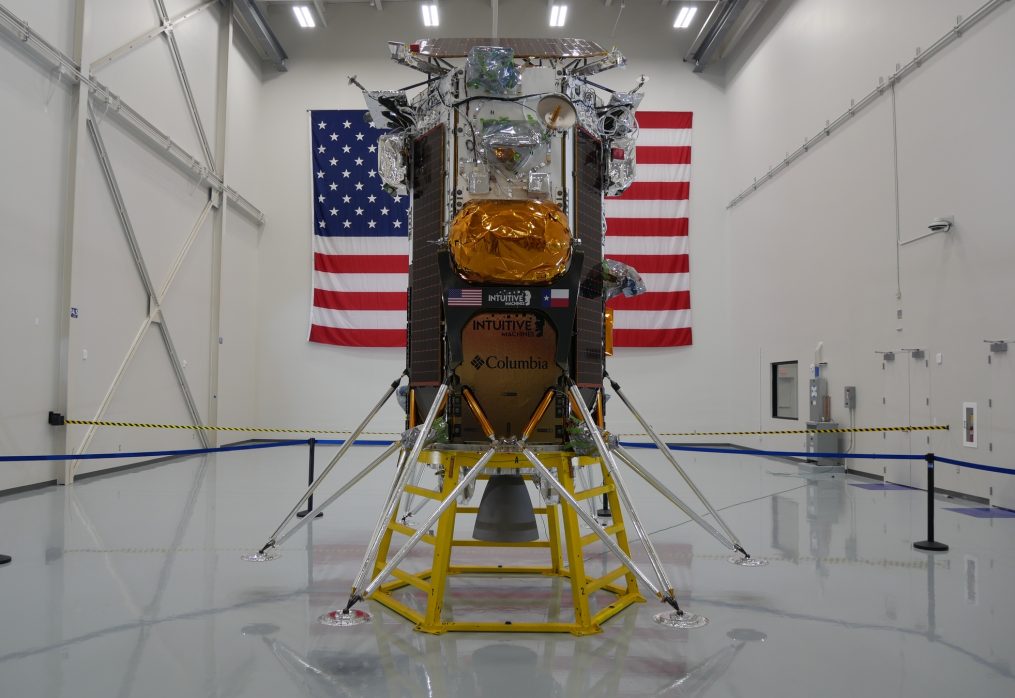First Intuitive Machines lunar lander ready for launch
HOUSTON — Intuitive Machines’ first lunar lander is complete and ready to ship for a launch next month as executives say they’re cautiously optimistic about the prospects of a successful landing.
The company unveiled its completed Nova-C lander at its new headquarters here Oct. 3, a day after completing a pre-ship review that confirmed that the spacecraft is ready to be transported to the Kennedy Space Center for launch on a Falcon 9 on a mission designated IM-1.
That launch is scheduled for a six-day period that opens Nov. 16 from KSC’s Launch Complex 39A. The lander will separate from the upper stage 32 minutes after launch and begin a five-day journey to the moon. A day after going into orbit around the moon, the spacecraft will attempt a landing at Malapert Crater, about 300 kilometers from the lunar south pole.
“We’re ready to go,” Tim Crain, chief technology officer of Intuitive Machines, said in an interview. Engineers completed all testing of the vehicle’s hardware and software ahead of shipment with no remaining issues to deal with before launch. “We’re really pleased about where we are.”
The biggest issue now for launch is out of the company’s hands: “pad congestion” at Launch Complex 39A, the launch site for the mission. There are several launches ahead of IM-1 on that pad, including the Falcon Heavy launch of Psyche that was recently delayed a week to Oct. 12. IM-1 is required to launch from LC-39A because only that pad is configured to fuel the lander with methane and liquid oxygen propellants shortly before liftoff.
“We’re working with SpaceX to try and thread the needle,” Crain said. “We’ll be ready to go on Nov. 16, but we’ve got to work through that pad congestion.” There is a backup launch opportunity in mid-December if IM-1 does not launch in November.
IM-1 is the company’s first lander mission and the first that is part of NASA’s Commercial Lunar Payload Services (CLPS) program, where the agency buys payload space on commercial landers. IM-1 is carrying five NASA payloads as well as six commercial payloads from customers ranging from Embry Riddle Aeronautical University to artist Jeff Koons.
IM-1 is seeking to become the first non-governmental spacecraft to successfully land on the moon. Beresheet, by Israeli venture SpaceIL, crashed trying to land on the moon in 2019, while HAKUTO-R M1 from Japanese company ispace crashed in a landing attempt in April.
Fewer than 45% of lunar landing missions, dating back to the beginning of the Space Age, have been successful, but Intuitive Machines executives expressed confidence in the changes IM-1 will make it to the surface successfully.
“I feel really good,” said Crain. He noted the company paid close attention to failed landing attempts to see if their Nova-C design was also susceptible to similar failure modes. For example, the Beresheet lander suffered problems with its inertial measurement units (IMUs) during its descent. Crain said Nova-C has dissimilar redundant IMUs to avoid a scenario like that.
Steve Altemus, chief executive of Intuitive Machines, estimated the odds of success at “upwards of 65% to 75%,” higher than the historical average. That’s based, he said, on the experience the company has built up with key technologies on the lander, such as precision landing and its propulsion system.
It is also based on lessons learned from those failed missions. “Each one of those things that we witnessed in terms of anomalies that caused the failures of those missions, we have internalized,” he said. “Therefore, I think our odds are higher.”
More than just IM-1
Company executives emphasized they are not betting the company on a single lander mission. The same high bay that has the completed IM-1 lander also has components for IM-2, ready to be assembled in the coming months.
“We have a chance of failure. I’m pretty open about that,” Altemus said. “But we have multiple missions to the moon. We have other business lines that diversify us and insulate us from failure.”
The company has three NASA CLPS awards for lunar lander missions but has also moved into other business areas. The company teamed with KBR to win a NASA engineering services contract called Omnibus Multidiscipline Engineering Services (OMES) III earlier this year that has a maximum value of $719 million over five years. Intuitive Machines also was one of three companies that won recent Air Force Research Lab contracts to work on designs of nuclear-powered spacecraft.
“Look at Intuitive Machines as a diversified space exploration company,” Altemus said, with several lines of business. In addition to its recent awards, the company is bidding on a NASA contract to provide communications services for its Near Space Network, supporting lunar missions, as well as NASA’s Lunar Terrain Vehicle lunar rover for future Artemis crewed missions.
Intuitive Machines, he said, “is a modern instantiation of an aerospace company that is not tied to the traditional cost-plus-award-fee contracting methods of the past but can live and work in a fixed price environment, or even NASA just buying a service.”
The company is also publicly traded after going public in February through a SPAC merger. Doing so helps bring more attention to the company, he argued, but also scrutiny. “Investors can be fickle and be hard on us at times,” he acknowledged. “If I continue to focus on growing the business for the long term and looking at creating real value for shareholders, that will win the day whether we succeed or fail in any given task.”
“We’re confident in the system we’re delivering to the Cape,” he said of IM-1, adding that employees are “elated” that the mission is nearing launch. “It’s time to go fly.”
